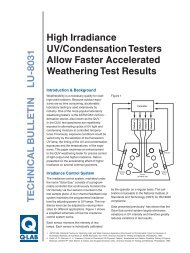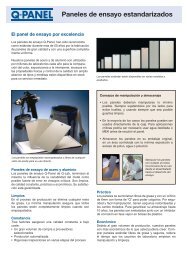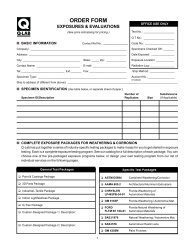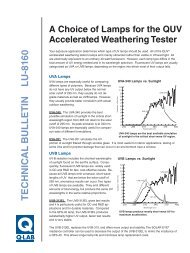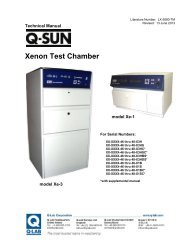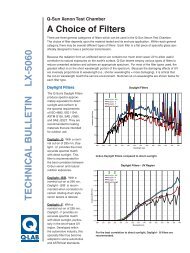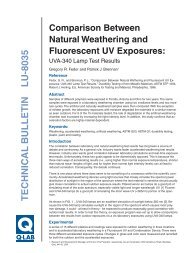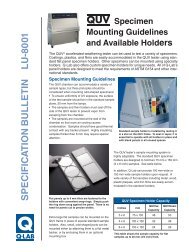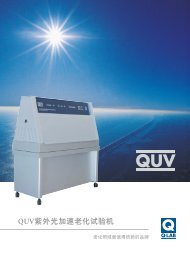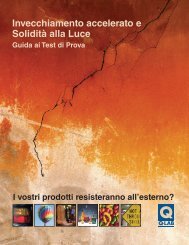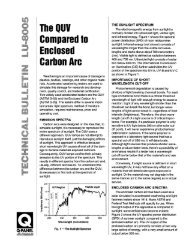Sunlight, Weathering, Light Stability - Q-Lab
Sunlight, Weathering, Light Stability - Q-Lab
Sunlight, Weathering, Light Stability - Q-Lab
You also want an ePaper? Increase the reach of your titles
YUMPU automatically turns print PDFs into web optimized ePapers that Google loves.
Irradiance (W/m 2 /nm)<br />
1.2<br />
1.0<br />
0.8<br />
0.6<br />
0.4<br />
0.2<br />
Xenon<br />
Exended UV<br />
<strong>Sunlight</strong><br />
0.0<br />
250 275 300 325 350 375 400<br />
Wavelength (nm)<br />
Figure 7A- Xenon with Extended UV Filters in the UV<br />
Irradiance Control. To control light intensity,<br />
modern xenon arc testers have a light monitoring<br />
system to compensate for the inevitable light<br />
output decay from lamp aging. The most common<br />
irradiance settings are 0.35 or 0.55 W/m 2 at 340<br />
nm. Figure 9 shows how these two settings compare<br />
to the Solar Maximum. While 0.55 is comparable<br />
to summer sunlight, 0.35 is comparable to<br />
winter sunlight. However, for historical reasons,<br />
0.35 is the most commonly used setting.<br />
Another irradiance setting that can be used is 0.68<br />
W/m 2 at 340 nm. This is the irradiance which is<br />
the best match with the Solar Maximum.<br />
Extended UV Filters allow significant excess UV<br />
below the cut-on of natural sunlight at the earth’s<br />
surface. Extended UV Filters are often used to<br />
produce faster degradation than Daylight Filters.<br />
They are required in many automotive test<br />
methods. They may also be used to reproduce<br />
extraterrestrial spectra for aerospace applications.<br />
See Figure 8 and Figure 8A.<br />
Irradiance (W/m 2 /nm)<br />
2.0<br />
1.5<br />
1.0<br />
0.5<br />
<strong>Sunlight</strong><br />
0.55 W/m 2<br />
0.35 W/m 2<br />
2.5<br />
Irradiance (W/m 2 /nm)<br />
Irradiance (W/m 2 /nm)<br />
2.0<br />
1.5<br />
1.0<br />
0.5<br />
<strong>Sunlight</strong><br />
Xenon<br />
Daylight<br />
0.0<br />
250 300 350 400 450 500 550 600 650 700<br />
Wavelength (nm)<br />
1.2<br />
1.0<br />
0.8<br />
0.6<br />
0.4<br />
0.2<br />
Figure 8- Xenon with Daylight Filters<br />
Xenon<br />
Daylight<br />
<strong>Sunlight</strong><br />
0.0<br />
250 275 300 325 350 375 400<br />
Wavelength (nm)<br />
Figure 8A- Xenon with Daylight Filters in the UV<br />
0.0<br />
250 350 450 550 650<br />
Wavelength (nm)<br />
Figure 9- Effect of Irradiance Setting<br />
Fluorescent UV. Unlike xenon arcs, QUV testers<br />
(ISO4892-3, ISO 11507, ASTM G154, SAE J2020)<br />
utilize different types of UV lamps, with different<br />
spectra for different exposure applications.<br />
FS-40 Lamps. In the early 1970’s, the FS-40<br />
became the first QUV machine lamp to achieve<br />
wide use. This lamp is currently specified in some<br />
automotive specifications, particularly for coatings.<br />
This lamp has demonstrated good correlation to<br />
outdoor exposures for gloss retention on coatings<br />
and for the material integrity of plastics. However,<br />
the short wavelength output below the solar cut-off<br />
can cause anomalous results, especially for color<br />
retention of plastics and textile materials.<br />
UVB-313 Lamps were introduced in 1984. The<br />
UVB-313 is essentially a second generation FS-<br />
40. It has the same SPD as the FS-40, but with<br />
higher, more stable output. Figure 10 shows the<br />
SPD of sunlight compared to the UVB-313 and the<br />
FS-40. Because of its higher output, the UVB-313<br />
gives significantly greater acceleration than the<br />
FS-40 for most materials. It is especially useful for<br />
Quality Control and research applications.<br />
5



